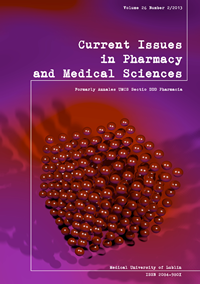Effect of bioadhesive agents on physico-chemical properties of suppositories
DOI:
https://doi.org/10.12923/j.2084-980X/26.2/a.16Keywords:
paracetamol, suppository bases, surfactantsAbstract
Dissolution rate of an active substance from suppositories may be altered by the qualitative and quantitative selection of suitable excipients. Thus, the accelerated-release or sustained-release suppositories can be manufactured. The objective of our study was to prepare the suppositories containing paracetamol in Novata BD and Novata BCF bases by the fusion method as well as to evaluate the influence of addition of the bioadhesive substances, namely: hydroxypropyl methyl cellulose (HPMC) and methylcellulose (MC) at concentrations of 5, 10, 15 and 20%, on the physico-chemical properties of suppositories. Assessment of the preparations were based on the outcomes of the following tests: uniformity of mass, uniformity of content of active substance, hardness of suppositories, softening time determination and the disintegration time of suppositories. Release of the active substance into the phosphate buffer at pH 7.2 was also performed. Content of the active substance was determined spectrophotometrically at 243 nm. On the basis of the obtained results it may be concluded that the addition of MC at concentrations of 15%, 20% and HPMC at concentrations of 5%, 10%,15%, 20% delays the release of active substance from suppositories. The physical properties of the prepared suppositories met the requirements of the Polish Pharmacopoeia, 9th edition.
References
1. Abass H, Kamel R, Abdelbary A.: Metronidazole biadhesive suppositories: formulation, in vitro and in vivo evaluation. Int. J. Pharm. Sci.,4 (1), 344, 2012.
2. Adegboye T., Itiola O.: Physical and release properties of metronidazole suppositories. Trop. J. Pharm. Res., 7, 887, 2008.
3. Brosard C.,Woussidjewe D.: Controle de dissolution des forms pharmaceutiques orales solides a liberation ralentie. S.T.P Pharma. Sci., 6, 728, 1990.
4. Czarnecki W, Kasperek R.: Nowy uniwersalny aparat do uwalniania substancji leczniczych z dozowanych postaci leku. Patent R.P.Nr P 337979 z 21.01.2000 r., Biomed Wytwórnia Surowic i Szczepionek w Lublinie.
5. El-Faharm T.H., Ibrahim S.A., Mostafa E.M., Tous S.S.: Formulation, release characteristics and evaluation of ibuprofen suppositories. Int. J. Pharm., 61, 1, 1990.
6. Herman T.W.: Recent research on bioavailability of drugs from suppositories. Int. J. Pharm., 123, 1, 1995.
7. Itolia O,A, Pilipel N.: Studies on metronidazole tablet formulations. J. Pharm. Pharmacol., 38, 81, 1986.
8. Nilufer T, Dilek E.: Preparation and in vitro evaluation of sustained release suppositories of indometacine. J. Faculty Pharm. Ankara., 27, 11, 1998.
9. Ozyazici M. et al.: In-vitro evaluation and vaginal absorption of metronidazole suppositories in rabbits. J. Drug Target., 11, 177, 2003.
10. Polish Pharmacopoeia IX, PZWL, Warsaw, 2011.
11. Shegokar R, Singh K: In-vitro release of paracetamol from suppocire suppositories: Role of additives. Malaysian Jurnal of Pharamceutical Sciences., Vol. 8, No. 1, 57, 2010.
12. Shegokar R, Singh K: Comparative evaluation of paediatric paracetamol suppositories in rabbits, First Indo-Japanese Conference, Mumbai, India 25-29 November 2005.
13. Zuber M. et al.: Kinetics of theophylline release from suppositories in vitro: Influence of physiochemical parameters. Int. J. Pharm., 47, 31, 1998.
Downloads
Published
Issue
Section
License
Copyright (c) 2013 Authors

This work is licensed under a Creative Commons Attribution-NonCommercial-NoDerivatives 3.0 Unported License.


